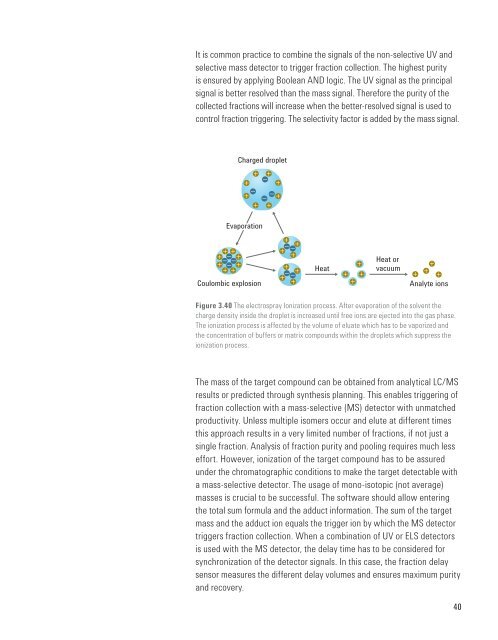Principles and Practical Aspects of Preparative Liquid Chromatography
You also want an ePaper? Increase the reach of your titles
YUMPU automatically turns print PDFs into web optimized ePapers that Google loves.
It is common practice to combine the signals <strong>of</strong> the non-selective UV <strong>and</strong><br />
selective mass detector to trigger fraction collection. The highest purity<br />
is ensured by applying Boolean AND logic. The UV signal as the principal<br />
signal is better resolved than the mass signal. Therefore the purity <strong>of</strong> the<br />
collected fractions will increase when the better-resolved signal is used to<br />
control fraction triggering. The selectivity factor is added by the mass signal.<br />
Charged droplet<br />
Evaporation<br />
Coulombic explosion<br />
Heat<br />
Heat or<br />
vacuum<br />
Analyte ions<br />
Figure 3.40 The electrospray Ionization process. After evaporation <strong>of</strong> the solvent the<br />
charge density inside the droplet is increased until free ions are ejected into the gas phase.<br />
The ionization process is affected by the volume <strong>of</strong> eluate which has to be vaporized <strong>and</strong><br />
the concentration <strong>of</strong> buffers or matrix compounds within the droplets which suppress the<br />
ionization process.<br />
The mass <strong>of</strong> the target compound can be obtained from analytical LC/MS<br />
results or predicted through synthesis planning. This enables triggering <strong>of</strong><br />
fraction collection with a mass-selective (MS) detector with unmatched<br />
productivity. Unless multiple isomers occur <strong>and</strong> elute at different times<br />
this approach results in a very limited number <strong>of</strong> fractions, if not just a<br />
single fraction. Analysis <strong>of</strong> fraction purity <strong>and</strong> pooling requires much less<br />
effort. However, ionization <strong>of</strong> the target compound has to be assured<br />
under the chromatographic conditions to make the target detectable with<br />
a mass-selective detector. The usage <strong>of</strong> mono-isotopic (not average)<br />
masses is crucial to be successful. The s<strong>of</strong>tware should allow entering<br />
the total sum formula <strong>and</strong> the adduct information. The sum <strong>of</strong> the target<br />
mass <strong>and</strong> the adduct ion equals the trigger ion by which the MS detector<br />
triggers fraction collection. When a combination <strong>of</strong> UV or ELS detectors<br />
is used with the MS detector, the delay time has to be considered for<br />
synchronization <strong>of</strong> the detector signals. In this case, the fraction delay<br />
sensor measures the different delay volumes <strong>and</strong> ensures maximum purity<br />
<strong>and</strong> recovery.<br />
40



